|
|
|
|
 HOLY MOUNTAINS, SACRED SITES HOLY MOUNTAINS, SACRED SITES
HAKUSAN MOUNTAINS
HAKUSAN 白山 (lit. white mountain) is the collective name for a number of sacred Japanese mountains that converge along the borders of four prefectures (Ishigawa, Fukui, Gifu, and Toyama) in northwest Honshū island. From early on, Hakusan was known as a “mountain realm inhabited by kami” (shintaisan 神体山). The character “shin” 神 is also read “kami,” which means Shintō deity. The mountains were once taboo to climb, but with the subsequent growth of Japan’s Shugendō cult of ascetic mountain practice, Hakusan became a popular site of worship, meditation, pilgrimage, and ascetic training.The deification and worship of Hakusan’s mountain kami is known as Hakusan Shinkō 白山信仰 (lit. = Hakusan faith), and today 2000+ nationwide Shirayama Jinja Shrines 白山神社 (also read Hakusan Shrines) are devoted to this faith. The characters for Hakusan are also read "Shirayama."
Hakusan is undeniably one of Japan’s most important and ancient sites of religious mountain worship (sangaku shūkyō 山岳宗). The Hakusan mountains are celebrated in the Man'yōshū 万葉集 (Japan’s oldest anthology of verse compiled in the 8th century). Over the centuries, Hakusan became a stronghold of Shintō-Buddhist syncretism, a major pilgrimage site, a center of ascetic practice for the Shugendō 修験道 cult of mountain worship, and the focus of artwork known as the Hakusan Mandala. Today Hakusan is considered one of Japan’s three most sacred mountain sites (Nihon Sanreizan 三霊山 or Nihon Sanmeisan 三名山). The other two are Mt. Fuji and Mt. Tateyama. See Holy Mountains for details.
Shirayamahime
Dragon Goddesss
of Hakusan |
|
 Sacred Hakusan Mountains Sacred Hakusan Mountains
The main Hakusan peaks are presented below.
- Gozenpō 御前峰 (also called Gozenmine or Gozengamine), 2702 meters. Located in Ishigawa Prefecture. The highest peak and the most sacred site in the Hakusan region. Home of the central Hakusan kami (deity) known as Shirayamahime 白山比売, who is enshrined at Shirayama Hime Jinja 白山比咩神社 (aka Hakusan Hongū Shrine 白山本宮) on Mt. Gozenpō. This sanctuary venerates three deities, but none are named after Shirayamahime. The three are Kukurihime no Kami (aka Shirayamahime no Kami), Izanagi no Kami, and Izanami no Kami. The latter two are creator gods in Japanese mythology. See Hakusan Deities below for details. There are three pilgrimage routes to the summit of this holy mountain. The main route begins in Ishigawa Prefecture (old province of Kaga) and is known as Hakusan Kagababa 白山加賀馬場.
- Ōnanjimine 大汝峰, 2684 meters. Located in Fukui Prefecture. One of the three most important peaks in the Hakusan mountains. The pilgrimage trail begins in Fukui Prefecture (old Echizen Province) and is known as Hakusan Echizenbaba 白山越前馬場, which leads pilgrims to Mt. Gozenpō in nearby Ishigawa Prefecture.
- Bessan 別山, 2399 meters. Located in Gifu Prefecture. One of the three most important peaks in the Hakusan mountains. The pilgrimage trail begins in Gifu Prefecture (old Mino Province) and is known as Hakusan Minobaba 白山美濃馬場, which leads pilgrims to Mt. Gozenpō in nearby Ishigawa Prefecture.
- Kengamine 剣ヶ峰 (lit. Sword Mountain), 2677 meters. Located behind Mt. Gozenpō. Sword Mountain is home to a green lake known as Midori-no-Ike 血ノ池 (also called Midori-ga-Ike みどりガ池). According to legend, those who drink from the lake’s water will gain long life. The deity Hakusan Myōri Daibosatsu (aka Hakusan Myōri Daigongen) was reportedly born here, and a nearby shrine was therefore erected to worship the deity. Hakusan Myōri is the Shintō counterpart of the Buddhist 11-Headed Kannon Bodhisattva. Hakusan Myōri is also a manifestation of Kukurihime no Kami 菊理媛神 (aka Shirayamahime, the central Shintō divinity of Hakusan).
- Ōkurayama 大倉山, 2039 m
- Sannomine 三ノ峰, 2128 m
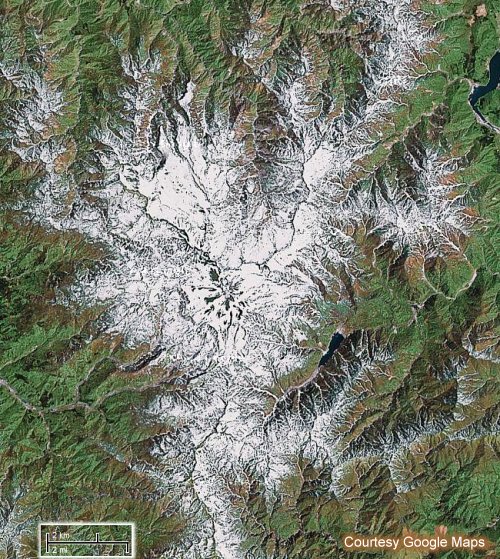
Snow-capped Hakusan is clearly visible by satellite.

|
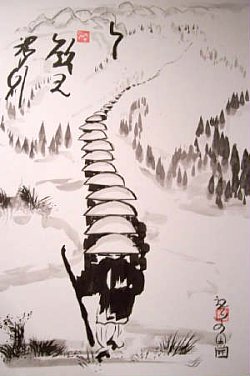
Zen Art by Qiao Seng
|
|
 Hakusan Pilgrimage Hakusan Pilgrimage
Legends suggest that Shugendō practitioner Taichō Shōnin 泰澄聖人 (682 – 767) was the founder of the Hakusan cult (白山信仰 Hakusan Shinkō). He reportedly climbed the mountains in 717, but his name does not appear in Nara-period documents. However, Taichō is mentioned in such Heian-era documents as the Taichō Kashō Denki 泰澄和尚伝記 and the Shirayama no Ki 白山之記, which strongly suggests that Hakusan was already a popular site for mountain pilgrimage in the 8th and 9th centuries.
Today the Shirayama Hime Shrine 白山比咩神社 (Shirayama Hime Jinja, also called Hakusan Jinja 白山神社) serves as the head shrine of a nationwide network of 2,000 to 3,000 shrines of the Hakusan cult. The head shrine is located on sacred Mt. Gozenpō. It is mentioned in an early 10th-century document called Engishiki 延喜式 (Procedures of the Engi Era), but in the centuries of Shintō-Buddhist syncretism (shinbutu shūgū 神仏習合) that followed, it became customary to read "Shirayama" as "Hakusan." The characters for both are 白山.
There are three main paths for climbing the mountains:
- Hakusan Kagababa 白山加賀馬場
- Hakusan Echizenbaba 白山越前馬場
- Hakusan Minobaba 白山美濃馬場.
Kaga, Echizen, and Mino are the old provincial names of the modern prefectures of Ishigawa, Fukui, and Gifu. All three routes lead to the summit of Mt. Gozenpō. The three pilgrimage routes are also called Zenjōdō 禅定道 (Paths of Meditation) and thus alternatively named Kaga Zenjōdō, Echizen Zenjōdō, and Mino Zenjōdō. Trail entrances to the mountains are called Baba 馬場. Along the route are seven important shrines called Hakusan Shichisha 白山七社(Seven Shrines of Hakusan). See details below.
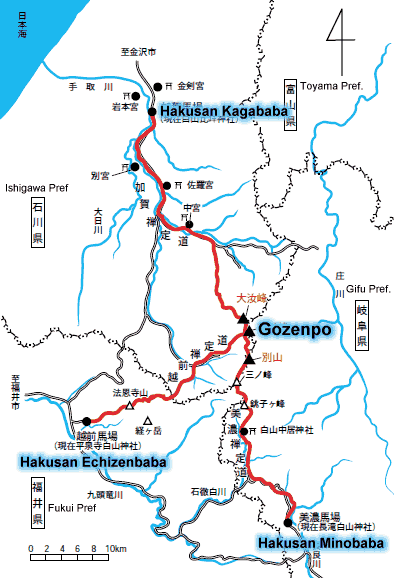
Three pilgrimage routes to the summit of holy Mt. Gozenpō
Courtesy: pref.ishikawa.jp/hakusan/publish/sizen/pdf/sizen21.pdf

Hakusan Deities
- Shinto Deities at Hakusan (Discussed Below): Shirayamahime | Izanami | Izanagi | Kukurihime | Hakusan Myōri Daigongen | Ōnamuchi no Kami | Ōyamatsumi no Kami | Hakusan Shichi Gongen | Hakusan Sansho Gongen | Hakusan Gongen | Betsuzan Daigyōji
- Buddhist Deities at Hakusan (links jump to other site pages)
Shō Kannon | 11-Headed Kannon | 1000-Armed Kannon | Amida | Fudō Myō-ō | Jizō Bodhisattva
From the 12th century onward, Hakusan was ruled by Enryakuji Temple 延暦寺 on Mt. Hiei 比叡 in Kyoto Prefecture, and thus copied the 21-shrine format (7-7-7 pattern) of the famous Sannō 山王 shrines at Mt. Hiei (see Hie Sannō Mandala 日吉山王曼荼羅). The main Hakusan deity is Shirayama-hime 白山比売 and her shrine-temple is known as Shirayama Hime Jinja 白山比咩神社 (aka Hakusan Hongū Shrine 白山本宮) and located on Mt. Gozenpō. Her group of seven shrines is the main group, and its seven protective deities are called the Hakusan Shichi Gongen 白山七権現 (Seven Avatars of Mt. Hakusan). There is another grouping of three called the Hakusan Sansho Gongen 白山三所権現 who represent the three deities of the three sacred mountains of Bessan 別山, Gozenpō 御前峰, and Ōnanjimine 大汝峰. The Buddhist counterparts (honjibutsu 本地仏) of the three are sometimes given as Shō Kannon 聖観音, Jūichimen Kannon 十一面観音 and Amida 阿弥陀, but this can vary depending on the source. Among Buddhists, the Hakusan mountains are considered a sanctuary of Kannon Bodhisattva. The main deities are presented below.
-
|
Dragon Goddesss of Hakusan |
|
 Shirayamahime no Kami 白山比売 (aka Kukurihime no Kami 菊理媛神 aka Hakusan Myōri Daibosatsu 白山妙理大菩薩) is the central kami of the Hakusan mountains. This deity is considered a “water kami” (suijin 水神), one who controls the rivers and seas. Since Hakusan’s peaks are the source of four great rivers (the Tedori, Kuzuryu, Nagara, and Sho), this association with water is easily understood. The deity is also considered a “dragon kami” (ryūjin 竜神). The dragon -- in both Shintō and Buddhist lore -- is a controller of rain, tempests, and tides. The local folk also venerate Shirayamahime as the patron deity of fishing and seafaring folk. Shirayamahime is enshrined on Mt. Gozenpō in the Shirayama Hime Jinja 白山比咩神社 (aka Hakusan Hongū Shrine 白山本宮), a sanctuary said to embody Kukurihime no Kami, Izanagi no Mikoto, and Izanami no Mikoto. See below for details. Shirayamahime no Kami 白山比売 (aka Kukurihime no Kami 菊理媛神 aka Hakusan Myōri Daibosatsu 白山妙理大菩薩) is the central kami of the Hakusan mountains. This deity is considered a “water kami” (suijin 水神), one who controls the rivers and seas. Since Hakusan’s peaks are the source of four great rivers (the Tedori, Kuzuryu, Nagara, and Sho), this association with water is easily understood. The deity is also considered a “dragon kami” (ryūjin 竜神). The dragon -- in both Shintō and Buddhist lore -- is a controller of rain, tempests, and tides. The local folk also venerate Shirayamahime as the patron deity of fishing and seafaring folk. Shirayamahime is enshrined on Mt. Gozenpō in the Shirayama Hime Jinja 白山比咩神社 (aka Hakusan Hongū Shrine 白山本宮), a sanctuary said to embody Kukurihime no Kami, Izanagi no Mikoto, and Izanami no Mikoto. See below for details.
- Kukurihime no Kami 菊理媛神 is mentioned in the Nihongi 日本紀 (Chronicles of Japan, written around 797 AD). Also known as Shirayamahime. Her Buddhist counterpart is the 11-Headed Kannon Bodhisattva, but in very early times this counterpart was first known as Hakusan Myōri Daibosatsu 白山妙理大菩薩. Kukurihime is worshipped along with Izanagi and Izanami (creator gods of Japanese mythology) at the main shrine on Mt. Gozenpō. In Japan’s creation myths, Kukurihime is the goddess who brought Izanami and Izanagi back together after they had argued. She is also known as the Dragon Goddess of Hakusan. The name “Kukurihime” suggests the deity possesses the power to bind or join together (to create harmony). The Japanese term Kukuru くくる is written with different characters, but it means “to bind, to tie together.” According to the Shirayama no Ki 白山之記 (a Heian-era document), Kukurihime is enshrined on Mt. Gozenpō, but that peak is also referred to as Zenjō 禅定 (meditation) – hence the Hakusan pilgrimage routes are sometimes known as Zenjōdō 禅定道 or Paths of Meditation.
-
|
Hakusan Myōri Daigongen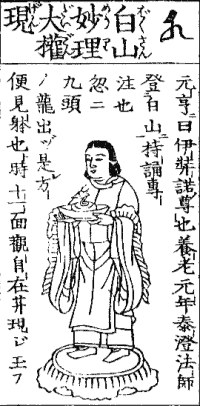
|
|
Image courtesy Butsuzō-zu-i 仏像図彙. Collected Illustrations of Buddhist Images. Published 1690 (Genroku 元禄 3). One of Japan's first major studies of Buddhist icons, with drawings by Tosa Hidenobu 土佐秀信 and text by Ito Takemi 伊藤武美. Hundreds of pages and drawings, with deities classified into some 80 (eighty) categories. Modern-day reprints are available for purchase at most large Japanese book stores. Click here to buy book online.
|
|
 Hakusan Myōri Gongen 白山妙理権現 (also called Hakusan Myōri Daigongen or Hakusan Myōri Daibosatsu). Identified with Shirayamahime and Kukurihime. Hakusan Myōri Gongen 白山妙理権現 (also called Hakusan Myōri Daigongen or Hakusan Myōri Daibosatsu). Identified with Shirayamahime and Kukurihime.
- Izanagi no Mikoto (伊邪那岐命 or 伊奘諾尊 or 伊耶那岐命) and Izanami no Mikoto (伊邪那美命 or 伊奘冉尊 or 伊耶那美命). Creator gods of Japan mentioned in all early Japanese texts. They are enshrined on Mt. Gozenpō along with Kukurihime.
- Ōnamuchi no Kami 大穴牟遅神 (or 大己貴神). An agricultural deity who is also Identified with the Shintō kami Ōkuninushi 大国主命 (the great land master). This deity’s Buddhist counterpart is Amida Buddha. Ōnamuchi is enshrined at Ōnanji Jinja 大汝神社 on Mt. Ōnanjimine. He is mentioned in both the Nihongi 日本紀 (Chronicles of Japan, written around 797 AD) and the Kojiki 古事記 (Record of Ancient Matters, released around 712 AD).
- Ōyamatsumi no Kami 大山津見神 (or 大山祇). Translated as “great deity of mountain jurisdiction.” A child of Izanagi and Izanami whose Buddhist counterpart is Shō Kannon. Ōyamatsumi is enshrined at Bessan Jinja 別山神社 on Mt. Bessan. This kami is mentioned in both the Nihongi 日本紀 (Chronicles of Japan, written around 797 AD) and the Kojiki 古事記 (Record of Ancient Matters, released around 712 AD). Ōyamatsumi is a mountain kami worshiped by hunters, charcoal-burners, and woodcutters. Also known as Yama no Kami 山の神 (lit. mountain kami).
- Hakusan Shichi Gongen 白山七権現. The Seven Avatars of Hakusan. They represent a group of seven shrines devoted to Shirayama-hime, the central deity of the Hakusan mountains.
- Hakusan Sansho Gongen 白山三所権現. Another grouping of Gongen. These three represent the three deities of Hakusan’s three sacred mountains: Bessan 別山, Gozenpō 御前峰, and Ōnanjimine 大汝峰. Their Buddhist counterparts (honjibutsu 本地仏) are often given as Shō Kannon 聖観音, Jūichimen Kannon 十一面観音 and Amida 阿弥陀. Although this can vary, the Hakusan mountains are considered (among Buddhists) to be a sanctuary for Kannon Bodhisattva. For more details, see JAANUS. One of the three, known as Hakusan Myōri Gongen 白山妙理権現, is identified with Kukurihime.
- Hakusan Gongen is the syncretic Shintō-Buddhist deity of Hakusan, once a great Shugendō center. Hakusan Gongen is an avatar of the Eleven-Headed Kannon, and also a representation of the Shintō creator god Izanami. Says Kokugakuin University: “The Shirayama no Ki (Heian-era document) states that the indigenous ’land master kami’ (jinushigami 地主神) gave this land to Hakusan Gongen, and then moved to Mount Bessan.”
- Betsuzan Daigyōji 別山大行事, the indigenous god of Mt. Gozenpō. Betsuzan’s Buddhist counterpart is Shō Kannon (the "pure" manifestation of Kannon Bodhisattva).
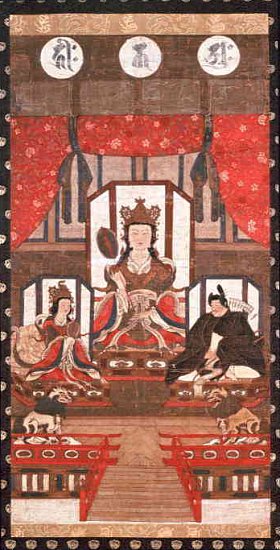
Three Deities of Hakusan 白山三社神像
Kamakura Period, Height 79.4 cm, Width 42.5 cm
Treasure of Shirayamahime Jinja 白山比咩神社
Important Cultural Property, Ishikawa Prefecture
Photo courtesy this J-Site
Central image = Hakusan Myōri Gongen 白山妙理権現 in female guise.
Left: Hakusan goddess Sannomiyahime 三宮姫 of Sannomiya Shrine 三宮.
Right: Male deity Kengamine Myōjin 剣明神 of Kinkengū Shrine 金釼宮.
Corresponding Buddhist Deities: C=11-Headed Kannon; L=1000-Armed Kannon; R=Dainichi Nyorai.
Two shishi lion-dogs shown at bottom; they serve as protectors of the sacred mountains.

|
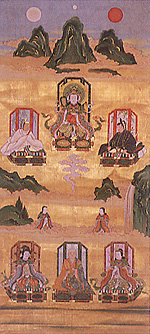
|
|
Hakusan Gongen Painting
白山大権現神
Treasure Nagataki Hakusan
長滝白山神社・白山長滝寺
Three peaks of Hakusan and their mountain avatars typically appear in such paintings, as does Taichō 泰澄 (d. 8th c), founder of the Hakusan cult.
|
|
 Hakusan Shrines Hakusan Shrines
Shirayamahime Shrines. The Shirayama Hongū Shrine 白山本宮 (aka Hakusan Hongū Shrine or Hakusan-ji Temple 白山寺) located on Mt. Gozenpō is the headquarters of over 2000+ nationwide Shirayama branch shrines-temples. Around 600,000 to 700,000 worshippers visit this central Hakusan shrine every year, which enshrines the Shintō creator god Izanagi and Shintō creator goddess Izanami and the main Shintō deity Shirayama-Hime (aka Kukurihime-no-Kami). The main seven shrines in the Hakusan grouping of 21 shrines are presented below along with their main honji-suijaka (Buddhist-Shintō) counterpart deities. Women are permitted pilgrimage as far as Chūgū.
- Hakusan Hongū 白山本宮
(11-Headed Kannon & Goddess Kukurihime)
- Kinkengū 金剱宮 (Kurikara Myō-ō & Princely Male Kami) **
- Sannomiya 三宮 (1000-Armed Kannon & Goddess of Hakusan)
- Iwamotogū 岩本宮 (Jizō Bodhisattva & Zenji Gongen & Priestly Kami)
- Chūgū 中宮 (Nyoirin Kannon, Goddess of Hakusan, Sansho Gongen 三所権現)
- Saranomiya or Saragū 佐羅宮 (Fudō Myō-ō, Male Prince)
- Bekkū or Betsugū 別宮 (11-Headed Kannon, Amida, Shō Kannon; Sansho Gongen 三所権現)
** Kurikara 倶利迦羅 is a dragon wound around a sword. Also called the Kurika 矩里迦, a transliteration of Sanskrit 'Kulika,' the name of a dragon-king mentioned in Indian legends. It sometimes appears in paintings of Fudō Myō-ō, who carries the "kurikara" or devil-subduing sword in right hand (used to smite the wicked; also represents wisdom cutting through ignorance). See JAANUS for more on the Kurikara.

Hakusan Mandala 白山曼荼羅
Classified as a Miya Mandala 宮曼荼羅 (i.e., devotional paintings of shrine or temple landscapes; a map-like illustration showing buildings, pathways, pilgrims, practitioners, priests and nuns, deities, and other scenes). Hakusan was a sacred mountain site from early times, a center of syncretic Shinto-Buddhist beliefs and a sacred training ground for the Shugendō 修験道 cult of mountain worship. For more details on the Hakusan Mandala, please see JAANUS.

Below text courtesy of outside link JAANUS:
From the 12c Hakusan was ruled over by Enryakuji 延暦寺 on Mt. Hiei 比叡 Kyoto, the head Tendai 天台 temple. For this reason the pattern of the Sannō 山王 shrines, with upper, middle, and lower groups of seven shrines adding up to 21 shrines, was copied in Hakusan (see Sannō mandara 山王曼荼羅). The main deity, Shirayamahime 白山比売, has her own Shrine known as Hakusan Hongū 白山本宮, or Hakusanji 白山寺 which contains three deities although none of them is called after her. The main group of seven deities, including that of Hongū was called the Hakusan Shichi Gongen 白山七権現. The Hakusan Sansho Gongen 白山三所権現 may be the deities of the mountains (Bessan 別山, Gozenpou 御前峰, and Oonanjimine 大汝峰) whose Buddhist counterparts honjibutsu 本地仏 may be identified as Shō Kannon 聖観音, Jūichimen Kannon 十一面観音 and Amida 阿弥陀, although they are sometimes vary. There are two famous paintings of the cult of Hakusan. In one of these the central figure is Shirayamahime 白山姫 called Myōri Daibosatsu 妙理大菩薩 who was the main deity of Hakusan. Below her and to either side are another female and a male deity of the main group placed before screens. Above are the bonji 梵字 (Siddham letters used as sound symbols of the deities) Dainichi 大日 (for the male), Jōichimen Kannon (for Myōri Daibosatsu) and Senju Kannon 千手観音. In the other painting the three peaks of Hakusan are shown above clouds while the Hakusan Shichi Gongen and several deities of minor shrines are shown below them. At the bottom of the painting Taichō sits on a rock at the foot of a waterfall. <end JAANUS quote>

JAPANESE DOCUMENTS
- Shirayama no Ki 白山之記 (Heian-era Japanese document)
- Taichō Kashō Denki 泰澄和尚伝記 (Heian-era Japanese document)
- Engishiki 延喜式 or Procedures of the Engi Era (10th-century Japanese document)
WEB RESOURCES
LEARN MORE

|
|